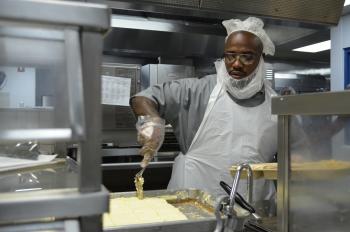NDCS facilities offer opportunities, experience through work release, work detail
NDCS facilities offer opportunities, experience through work release, work detail
FOR IMMEDIATE RELEASE (18-30)
CONTACT Cara Wilwerding, Communications Manager
OFFICE 402-479-5799 | cara.wilwerding@nebraska.gov
Oct. 29, 2018 (LINCOLN, Neb.) – There are many challenges associated with re-entering society following incarceration. Finding employment is one of them. But, opportunities provided through two Nebraska Department of Correctional Services (NDCS) facilities offer participants the type of training they need to transition back into the community and become successful.
“They’re getting back into the rhythm of working again,” said Lorna Ellinger, unit case worker at the Community Corrections Center – Lincoln (CCC-L). “A lot of them are just trying to give back.”
That facility, as well as the Community Corrections Center-Omaha (CCC-O), provides many options for incarcerated individuals. Individuals assigned to work detail complete jobs within NDCS facilities including landscaping, construction, administration, and janitorial services. In addition, there are opportunities to cook, clean and provide tours in the Governor’s Residence. Those who are assigned to work release hold a variety of jobs within the community.
After 25 years in prison, Darren McCracken works as a teacher’s aide, while completing his sentence at CCC-L. He helps other incarcerated men and women to obtain their GED. “The job was available and I had my GED, so I went for it,” he said. “It is very helpful.”
McCracken gained the necessary skills by participating in the NDCS grant-funded TRADE (Tackling Recidivism and Developing Employability) program. The program – an initiative through the Center for People in Need (CFPIN) – provides a variety of vocational and life skills training services to those transitioning out of the criminal justice system. McCracken recently finished a six-week basic computer course with TRADE, where he learned how to use applications such as Microsoft Word, PowerPoint and Excel. Next, he’s hoping to get his forklift certification.
Charles Blowers recently obtained his forklift certification, along with a construction certification and food handlers permit through TRADE. He has been doing janitorial work at CCC-L and trains other inmates as well as checking inventory.
“It got me back to being worthwhile,” he said. “I’ve had multiple staff members and inmates comment on the cleanliness of the unit. It helped me have a feeling of worth.”
Now, Blowers is making the transition to work release. Those on work release hold positions in restaurants, with construction and landscaping companies, manufacturing plants and other local businesses
CCC-L and CCC-O conduct orientation sessions to assist with the transition to work release. Individuals must have a state ID or driver’s license and a social security card prior to orientation. During the sessions, participants learn how to complete job applications, how to obtain transportation to and from work and how to talk about their incarceration during job interviews.
“It was informative to sit and listen, ask questions and fill out forms,” Blowers said. “It’s helped me get into a position to succeed. To find a job to fulfill my destiny.”
Stacia Keener, who has been incarcerated for a year and a half, went through a similar job hunt before landing a position as a server at IHOP. She worked there four months before taking a new job at Old Chicago, which was a closer commute by bus.
Keener, who was the lead canteen supervisor at CCC-L on work detail, is now serving at Old Chicago 35-45 hours per week. “Working in the canteen gave me the confidence boost that I needed. That people would trust me to handle money.”
Building that confidence took time. Prior to incarceration, Keener said she never had trouble finding a job. Now, with a felony record, it is more challenging to deal with the questions that employers might ask. Spending time at CCC-L and going to orientation sessions helped her realize that second chances were possible.
“I thought my life was over, but it’s not,” Keener observed. “I’ve been working since I was 15, so it’s not so much learning new job skills as it is learning to deal with the stigma.”
Ellinger, who has been in corrections for 30 years, works to break down the stigma of incarceration every day. She said it is imperative that incarcerated individuals go through programming, volunteer, get back in the community and rejoin the workforce.
“They’ve done their time and they need to make positive changes so they don’t come back here,” Ellinger noted. “I just want to see people succeed.”
###

